Screen-Printed Graphite Electrode Modified with Graphene-Co3O4 Nanocomposite: Voltammetric Assay of Morphine in the Presence of Diclofenac in Pharmaceutical and Biological Samples
Abstract
:1. Introduction
2. Materials and Methods
2.1. Equipments
2.2. Solvents and Chemicals
2.3. Preparation of Graphene-Co3O4 Nanocomposite
2.4. Preparation of the Graphene-Co3O4/SPGE Sensor
2.5. Preparation of Real Samples
3. Results and Discussion
3.1. Characterization of Graphene-Co3O4 Nanocomposite
3.2. Electrochemical Response of Morphine on Diverse Electrodes
3.3. Effect of Scan Rate
3.4. Chronoamperometric Analysis
3.5. DPV Analysis of Morphine
3.6. DPV Analysis for Determination of Morphine in the Presence of Diclofenac
3.7. Reproducibility, and Stability
3.8. Interference Study
3.9. Analysis of Real Specimens
4. Conclusions
Author Contributions
Funding
Data Availability Statement
Conflicts of Interest
References
- Barthwal, S.; Singh, B.; Singh, N.B. A novel electrochemical sensor fabricated by embedding ZnO nano particles on MWCNT for morphine detection. Mater. Today: Proc. 2018, 5, 9061–9066. [Google Scholar] [CrossRef]
- Maccaferri, G.; Terzi, F.; Xia, Z.; Vulcano, F.; Liscio, A.; Palermo, V.; Zanardi, C. Highly sensitive amperometric sensor for morphine detection based on electrochemically exfoliated graphene oxide. Application in screening tests of urine samples. Sens. Actuators B Chem. 2019, 281, 739–745. [Google Scholar] [CrossRef] [Green Version]
- Dehdashtian, S.; Gholivand, M.B.; Shamsipur, M. Construction of a sensitive and selective sensor for morphine using chitosan coated Fe3O4 magnetic nanoparticle as a modifier. Mater. Sci. Eng. C 2016, 58, 53–59. [Google Scholar] [CrossRef]
- Eissa, S.; Zourob, M. Competitive voltammetric morphine immunosensor using a gold nanoparticle decorated graphene electrode. Microchim. Acta 2017, 184, 2281–2289. [Google Scholar] [CrossRef]
- Schug, S.A.; Sidebotham, D.A.; McGuinnety, M.; Thomas, J.; Fox, L. Acetaminophen as an adjunct to morphine by patient-controlled analgesia in the management of acute postoperative pain. Anesth. Analg. 1998, 87, 368–372. [Google Scholar] [CrossRef]
- Goyal, R.N.; Chatterjee, S.; Agrawal, B. Electrochemical investigations of diclofenac at edge plane pyrolytic graphite electrode and its determination in human urine. Sens. Actuators B Chem. 2010, 145, 743–748. [Google Scholar] [CrossRef]
- Eteya, M.M.; Rounaghi, G.H.; Deiminiat, B. Fabrication of a new electrochemical sensor based on AuPt bimetallic nanoparticles decorated multi-walled carbon nanotubes for determination of diclofenac. Microchem. J. 2019, 144, 254–260. [Google Scholar] [CrossRef]
- Arvand, M.; Gholizadeh, T.M.; Zanjanchi, M.A. MWCNTs/Cu(OH)2 nanoparticles/IL nanocomposite modified glassy carbon electrode as a voltammetric sensor for determination of the non-steroidal anti-inflammatory drug diclofenac. Mater. Sci. Eng. C 2012, 32, 1682–1689. [Google Scholar] [CrossRef]
- Izhar, M.; Folker, A.; Gandhi, A.; Alausa, T.; Alam, A.; Bakris, G.L. P-228: A comparative study of celecoxib versus diclofenac on blood pressure control and renal function in hypertensive African Americans and Hispanics: A randomized crossover study. Am. J. Hypertens. 2002, 15, 112A. [Google Scholar] [CrossRef] [Green Version]
- Fatta-Kassinos, D.; Hapeshi, E.; Achilleos, A.; Meric, S.; Gros, M.; Petrovic, M.; Barcelo, D. Existence of pharmaceutical compounds in tertiary treated urban wastewater that is utilized for reuse applications. Water Resour. Manag. 2011, 25, 1183–1193. [Google Scholar] [CrossRef]
- Miranda, H.F.; Silva, E.; Pinardi, G. Synergy between the antinociceptive effects of morphine and NSAIDs. Can. J. Physiol. Pharmacol. 2004, 82, 331–338. [Google Scholar] [CrossRef] [PubMed]
- Abdolmohammad-Zadeh, H.; Zamani, A.; Shamsi, Z. Preconcentration of morphine and codeine using a magnetite/reduced graphene oxide/silver nano-composite and their determination by high-performance liquid chromatography. J. Chromatogr. A 2019, 1590, 2–9. [Google Scholar] [CrossRef]
- Nakhaei, J.M.; Jamali, M.R.; Sohrabnezhad, S.; Rahnama, R. Solvent-Assisted dispersive solid phase extraction of diclofenac from human serum and pharmaceutical tablets quantified by high-performance liquid chromatography. Microchem. J. 2020, 152, 104260. [Google Scholar] [CrossRef]
- Abbott, R.W.; Townshend, A.; Gill, R. Determination of morphine by flow injection analysis with chemiluminescence detection. Analyst 1986, 111, 635–640. [Google Scholar] [CrossRef]
- Song, J.; Sun, P.; Ji, Z.; Li, J. Flow injection determination of diclofenac sodium based on its sensitizing effect on the chemiluminescent reaction of acidic potassium permanganate–formaldehyde. Luminescence 2015, 30, 32–37. [Google Scholar] [CrossRef]
- Sebaiy, M.M.; El-Shanawany, A.A.; Baraka, M.M.; Abdel-Aziz, L.M.; Isbell, T.A.; Colyer, C.L. Determination of morphine and its metabolites in human urine by capillary electrophoresis with laser induced fluorescence detection employing on-column labeling with a new boronic acid functionalized squarylium cyanine dye. Separations 2016, 3, 1. [Google Scholar] [CrossRef]
- Cunha, R.R.; Gimenes, D.T.; Munoz, R.A.; do Lago, C.L.; Richter, E.M. Simultaneous determination of diclofenac and its common counter-ions in less than 1 minute using capillary electrophoresis with contactless conductivity detection. Electrophoresis 2013, 34, 1423–1428. [Google Scholar] [CrossRef]
- Rondina, R.V.; Bandoni, A.L.; Coussio, J.D. Quantitative determination of morphine in poppy capsules by differential spectrophotometry. J. Pharm. Sci. 1973, 62, 502–504. [Google Scholar] [CrossRef]
- Gabhane, K.B.; Kasture, A.V.; Shrikhande, V.N.; Barde, L.N.; Wankhade, V.P. Simultaneous spectrophotometric determination of metaxalone and diclofenac potassium in combined tablet dosage form. Int. J. Chem. Sci. 2009, 7, 539–545. [Google Scholar]
- Tang, S.H.; Chuang, C.H.; Chen, S.F.; Chuang, W.C.; Shang, H.S. Optimized procedures for simultaneous quantitation of low concentration levels of morphine and codeine in urine using gas chromatography–mass spectrometry. J. Med. Sci. 2020, 40, 68. [Google Scholar]
- Česen, M.; Heath, E. Disk-based solid phase extraction for the determination of diclofenac and steroidal estrogens E1, E2 and EE2 listed in the WFD watch list by GC–MS. Sci. Total Environ. 2017, 590, 832–837. [Google Scholar] [CrossRef] [PubMed]
- Kaale, E.; Nyamweru, B.C.; Manyanga, V.; Chambuso, M.; Layloff, T. The development and validation of a Thin Layer Chromatography densitometry method for the analysis of diclofenac sodium tablets. Int. J. Chem. Anal. Sci. 2013, 4, 73–79. [Google Scholar] [CrossRef]
- Yang, J.; He, D.; Zhang, N.; Hu, C. Disposable carbon nanotube-based antifouling electrochemical sensors for detection of morphine in unprocessed coffee and milk. J. Electroanal. Chem. 2022, 905, 115997. [Google Scholar] [CrossRef]
- Kumary, V.A.; Abraham, P.; Renjini, S.; Swamy, B.K.; Nancy, T.M.; Sreevalsan, A. A novel heterogeneous catalyst based on reduced graphene oxide supported copper coordinated amino acid–A platform for morphine sensing. J. Electroanal. Chem. 2019, 850, 113367. [Google Scholar] [CrossRef]
- Mekassa, B.; Baker, P.G.; Chandravanshi, B.S.; Tessema, M. Synthesis, characterization, and preparation of nickel nanoparticles decorated electrochemically reduced graphene oxide modified electrode for electrochemical sensing of diclofenac. J. Solid State Electrochem. 2018, 22, 3607–3619. [Google Scholar] [CrossRef]
- Kimuam, K.; Rodthongkum, N.; Ngamrojanavanich, N.; Chailapakul, O.; Ruecha, N. Single step preparation of platinum nanoflowers/reduced graphene oxide electrode as a novel platform for diclofenac sensor. Microchem. J. 2020, 155, 104744. [Google Scholar] [CrossRef]
- Akbarian, Y.; Shabani-Nooshabadi, M.; Karimi-Maleh, H. Fabrication of a new electrocatalytic sensor for determination of diclofenac, morphine and mefenamic acid using synergic effect of NiO-SWCNT and 2,4-dimethyl-N/-[1-(2, 3-dihydroxy phenyl) methylidene] aniline. Sens. Actuators B: Chem. 2018, 273, 228–233. [Google Scholar] [CrossRef]
- Mohammadzadeh Jahani, P.; Mohammadi, S.Z.; Khodabakhshzadeh, A.; Cha, J.H.; Shahedi Asl, M.; Shokouhimehr, M.; Peng, W.X. Simultaneous detection of morphine and diclofenac using graphene nanoribbon modified screen-printed electrode. Int. J. Electrochem. Sci. 2020, 15, 9037–9048. [Google Scholar] [CrossRef]
- Baezzat, M.R.; Tavakkoli, N.; Zamani, H. Construction of a new electrochemical sensor based on MoS2 nanosheets modified graphite screen printed electrode for simultaneous determination of diclofenac and morphine. Anal. Bioanal. Chem. Res. 2022, 9, 153–162. [Google Scholar]
- Razmi, E.D.; Beitollahi, H.; Mahani, M.T.; Anjomshoa, M. TiO2/Fe3O4/multiwalled carbon nanotubes nanocomposite as sensing platform for simultaneous determination of morphine and diclofenac at a carbon paste electrode. Russ. J. Electrochem. 2018, 54, 1132–1140. [Google Scholar] [CrossRef]
- Mokhtari, A.; Karimi-Maleh, H.; Ensafi, A.A.; Beitollahi, H. Application of modified multiwall carbon nanotubes paste electrode for simultaneous voltammetric determination of morphine and diclofenac in biological and pharmaceutical samples. Sens. Actuators B: Chem. 2012, 169, 96–105. [Google Scholar] [CrossRef]
- Antuña-Jiménez, D.; González-García, M.B.; Hernández-Santos, D.; Fanjul-Bolado, P. Screen-printed electrodes modified with metal nanoparticles for small molecule sensing. Biosensors 2020, 10, 9. [Google Scholar] [CrossRef] [PubMed] [Green Version]
- Beitollahi, H.; Garkani Nejad, F.; Dourandish, Z.; Tajik, S. A novel voltammetric amaranth sensor based on screen printed electrode modified with polypyrrole nanotubes. Environ. Res. 2022, 214, 113725. [Google Scholar] [CrossRef]
- Yan, L.; Zhang, C.; Xi, F. Disposable amperometric label-free immunosensor on chitosan–graphene-modified patterned ITO electrodes for prostate specific antigen. Molecules 2022, 27, 5895. [Google Scholar] [CrossRef] [PubMed]
- Ma, K.; Yang, L.; Liu, J.; Liu, J. Electrochemical sensor nanoarchitectonics for sensitive detection of uric acid in human whole blood based on screen-printed carbon electrode equipped with vertically-ordered mesoporous silica-nanochannel film. Nanomaterials 2022, 12, 1157. [Google Scholar] [CrossRef] [PubMed]
- Wang, K.; Yang, L.; Huang, H.; Lv, N.; Liu, J.; Liu, Y. Nanochannel array on electrochemically polarized screen printed carbon electrode for rapid and sensitive electrochemical determination of clozapine in human whole blood. Molecules 2022, 27, 2739. [Google Scholar] [CrossRef] [PubMed]
- Sabeti, M.; Ensafi, A.A.; Rezaei, B. Polydopamine-modified MWCNTs-glassy Carbon Electrode, a Selective Electrochemical Morphine Sensor. Electroanalysis 2021, 33, 2286–2295. [Google Scholar] [CrossRef]
- Abraham, P.; Renjini, S.; Nancy, T.E.; Kumary, V.A. Electrochemical synthesis of thin-layered graphene oxide-poly (CTAB) composite for detection of morphine. J. Appl. Electrochem. 2020, 50, 41–50. [Google Scholar] [CrossRef]
- Atta, N.F.; Galal, A.; Azab, S.M. Electrochemical morphine sensing using gold nanoparticles modified carbon paste electrode. Int. J. Electrochem. Sci. 2011, 6, 5066–5081. [Google Scholar]
- Atta, N.F.; Galal, A.; Abdel-Gawad, F.M.; Mohamed, E.F. Electrochemical morphine sensor based on gold nanoparticles metalphthalocyanine modified carbon paste electrode. Electroanalysis 2015, 27, 415–428. [Google Scholar] [CrossRef]
- Qian, L.; Durairaj, S.; Prins, S.; Chen, A. Nanomaterial-based electrochemical sensors and biosensors for the detection of pharmaceutical compounds. Biosens. Bioelectron. 2021, 175, 112836. [Google Scholar] [CrossRef] [PubMed]
- Cheng, Z.; Li, M.; Dey, R.; Chen, Y. Nanomaterials for cancer therapy: Current progress and perspectives. J. Hematol. Oncol. 2021, 14, 1–27. [Google Scholar] [CrossRef] [PubMed]
- Yun, Q.; Li, L.; Hu, Z.; Lu, Q.; Chen, B.; Zhang, H. Layered transition metal dichalcogenide-based nanomaterials for electrochemical energy storage. Adv. Mater. 2020, 32, 1903826. [Google Scholar] [CrossRef]
- Li, F.; Song, J.; Shan, C.; Gao, D.; Xu, X.; Niu, L. Electrochemical determination of morphine at ordered mesoporous carbon modified glassy carbon electrode. Biosens. Bioelectron. 2010, 25, 1408–1413. [Google Scholar] [CrossRef]
- Nazari, Z.; Es’ haghi, Z. A new electrochemical sensor for the simultaneous detection of morphine and methadone based on thioglycolic acid decorated CdSe doped graphene oxide multilayers. Anal. Bioanal. Electrochem. 2022, 14, 228–245. [Google Scholar]
- Shalauddin, M.; Akhter, S.; Basirun, W.J.; Bagheri, S.; Anuar, N.S.; Johan, M.R. Hybrid nanocellulose/f-MWCNTs nanocomposite for the electrochemical sensing of diclofenac sodium in pharmaceutical drugs and biological fluids. Electrochim. Acta 2019, 304, 323–333. [Google Scholar] [CrossRef]
- Istrate, O.M.; Rotariu, L.; Bala, C. Electrochemical determination of NADH using screen printed carbon electrodes modified with reduced graphene oxide and poly (allylamine hydrochloride). Microchim. Acta 2016, 183, 57–65. [Google Scholar] [CrossRef]
- Gong, J.; Tang, H.; Wang, M.; Lin, X.; Wang, K.; Liu, J. Novel three-dimensional graphene nanomesh prepared by facile electro-etching for improved electroanalytical performance for small biomolecules. Mater. Des. 2022, 215, 110506. [Google Scholar] [CrossRef]
- Zhou, H.; Dong, G.; Sailjoi, A.; Liu, J. Facile pretreatment of three-dimensional graphene through electrochemical polarization for improved electrocatalytic performance and simultaneous electrochemical detection of catechol and hydroquinone. Nanomaterials 2021, 12, 65. [Google Scholar] [CrossRef]
- Zhou, H.; Ma, X.; Sailjoi, A.; Zou, Y.; Lin, X.; Yan, F.; Liu, J. Vertical silica nanochannels supported by nanocarbon composite for simultaneous detection of serotonin and melatonin in biological fluids. Sens. Actuators B Chem. 2022, 353, 131101. [Google Scholar] [CrossRef]
- Chen, S.; Zhu, J.; Wu, X.; Han, Q.; Wang, X. Graphene oxide-MnO2 nanocomposites for supercapacitors. ACS Nano 2010, 4, 2822–2830. [Google Scholar] [CrossRef] [PubMed]
- Ganesamurthi, J.; Keerthi, M.; Chen, S.M.; Shanmugam, R. Electrochemical detection of thiamethoxam in food samples based on Co3O4 Nanoparticle@Graphitic carbon nitride composite. Ecotoxicol. Environmen. Saf. 2020, 189, 110035. [Google Scholar] [CrossRef] [PubMed]
- Wang, X.; Dong, X.; Wen, Y.; Li, C.; Xiong, Q.; Chen, P. A graphene–cobalt oxide based needle electrode for non-enzymatic glucose detection in micro-droplets. Chem. Commun. 2012, 48, 6490–6492. [Google Scholar] [CrossRef] [PubMed]
- Liang, K.; Fu, X.; Wu, L.; Qin, Y.; Song, Y. A novel tyrosinase biosensor based on graphene and Co3O4 nanocomposite materials for rapid determining catechol. Int. J. Electrochem. Sci. 2016, 11, 250–258. [Google Scholar]
- Zhang, J.; Yang, L.; Pei, J.; Tian, Y.; Liu, J. A reagentless electrochemical immunosensor for sensitive detection of carcinoembryonic antigen based on the interface with redox probe-modified electron transfer wires and effectively immobilized antibody. Front. Chem. 2022, 10, 939736. [Google Scholar] [CrossRef]
- Jana, M.; Saha, S.; Khanra, P.; Murmu, N.C.; Srivastava, S.K.; Kuila, T. Bioreduction of graphene oxide using drained water from soaked mung beans (Phaseolus aureus L.) and its application as energy storage electrode material. Mater. Sci. Eng. B 2014, 186, 33–40. [Google Scholar] [CrossRef]
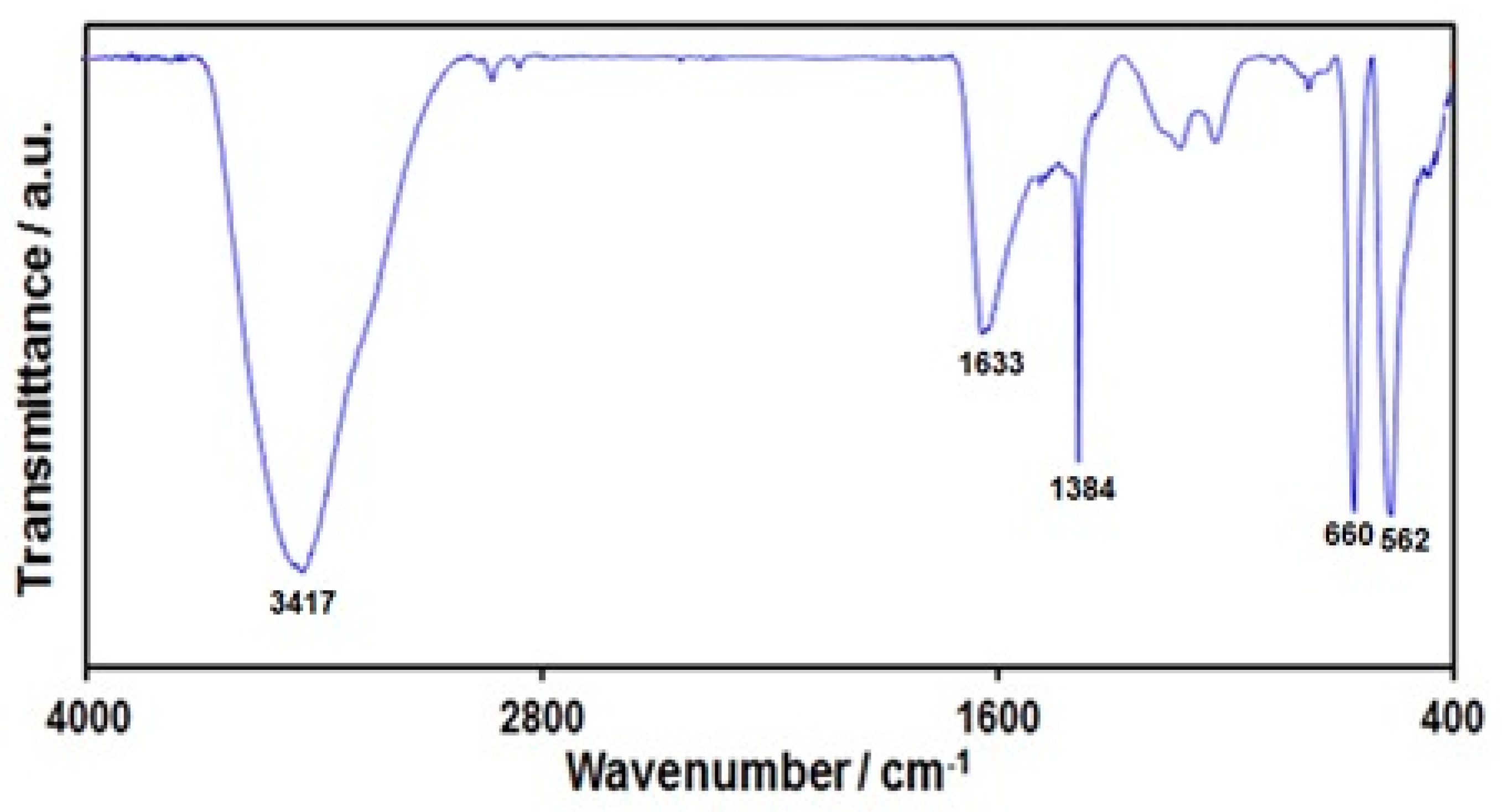
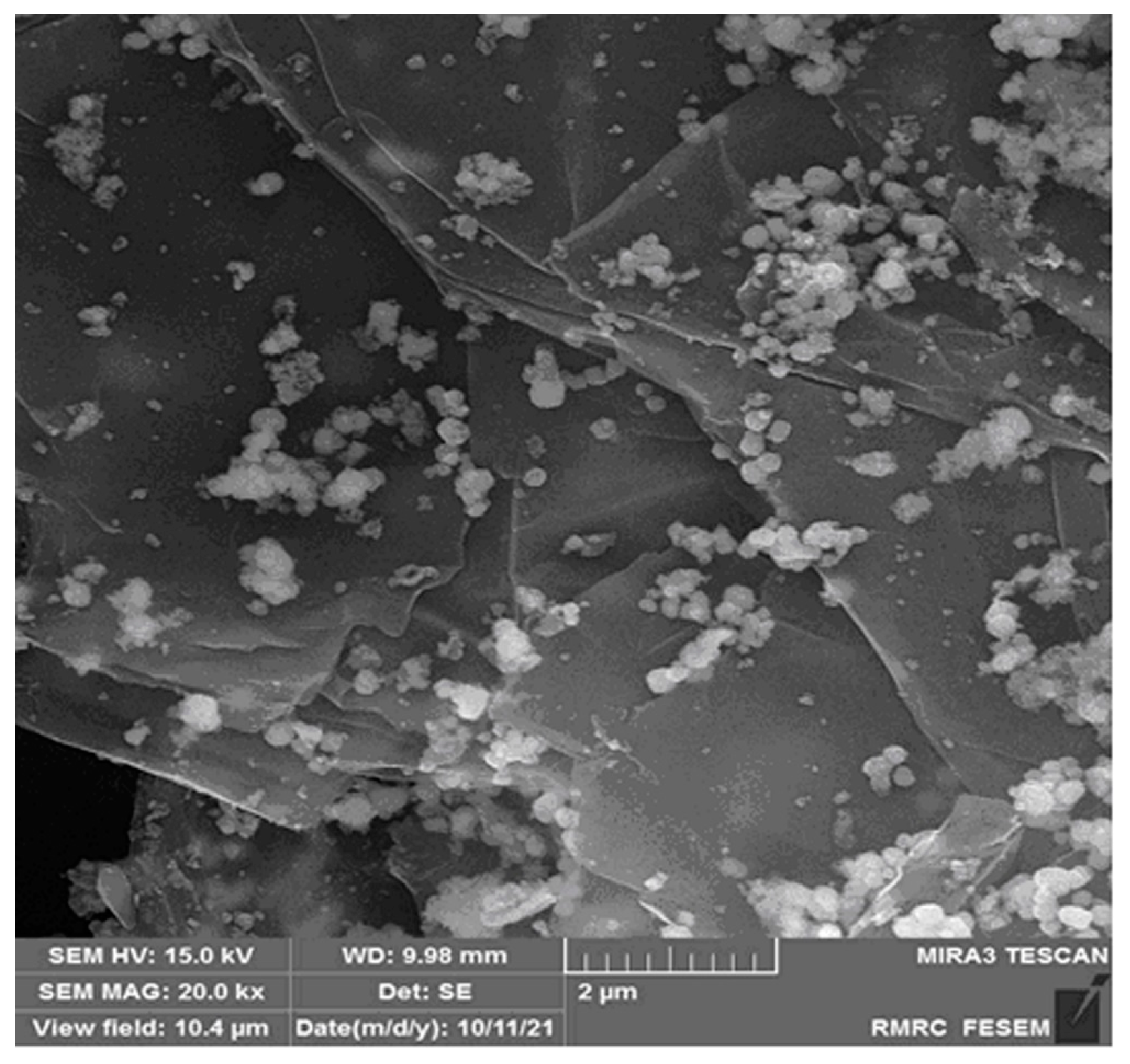
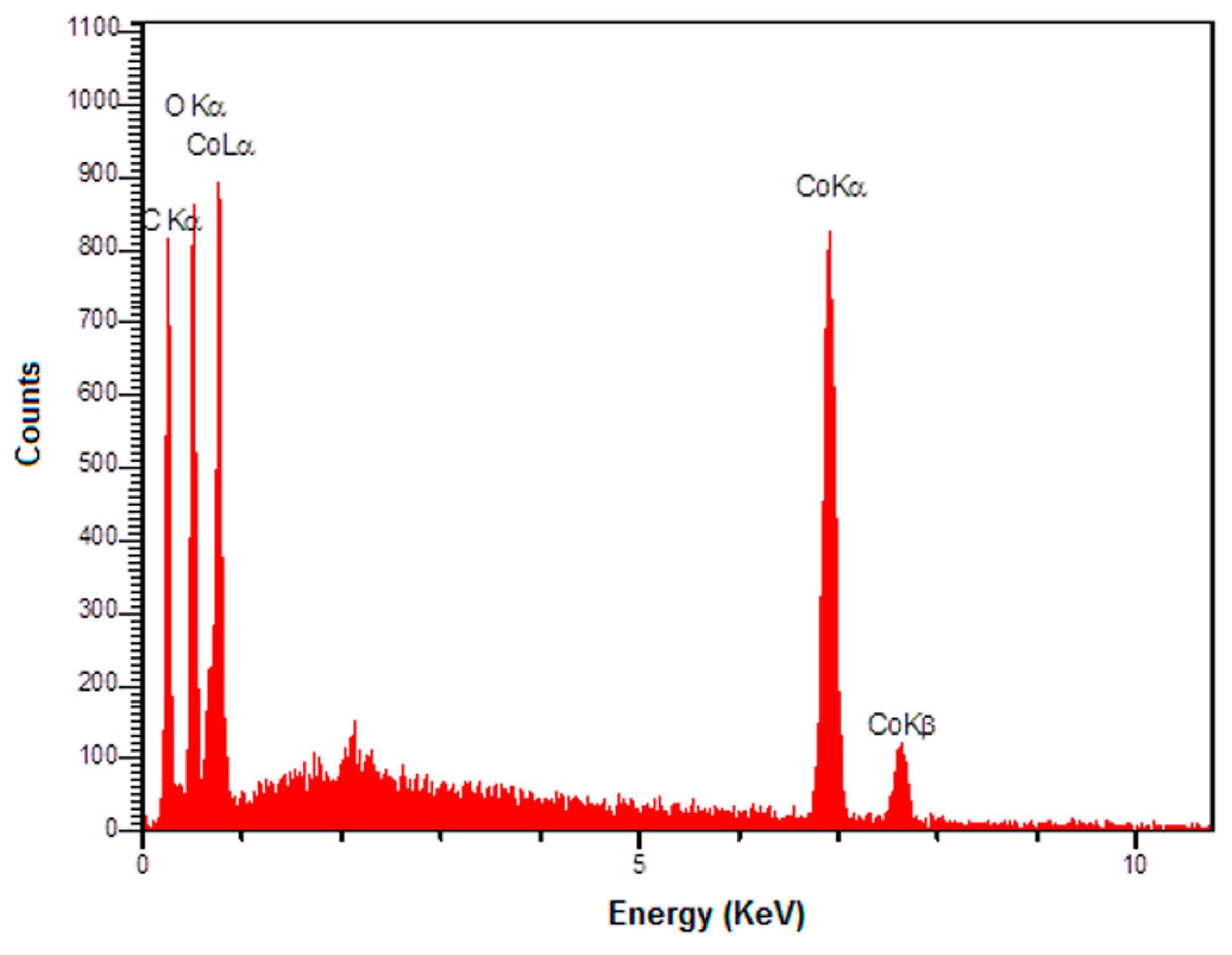

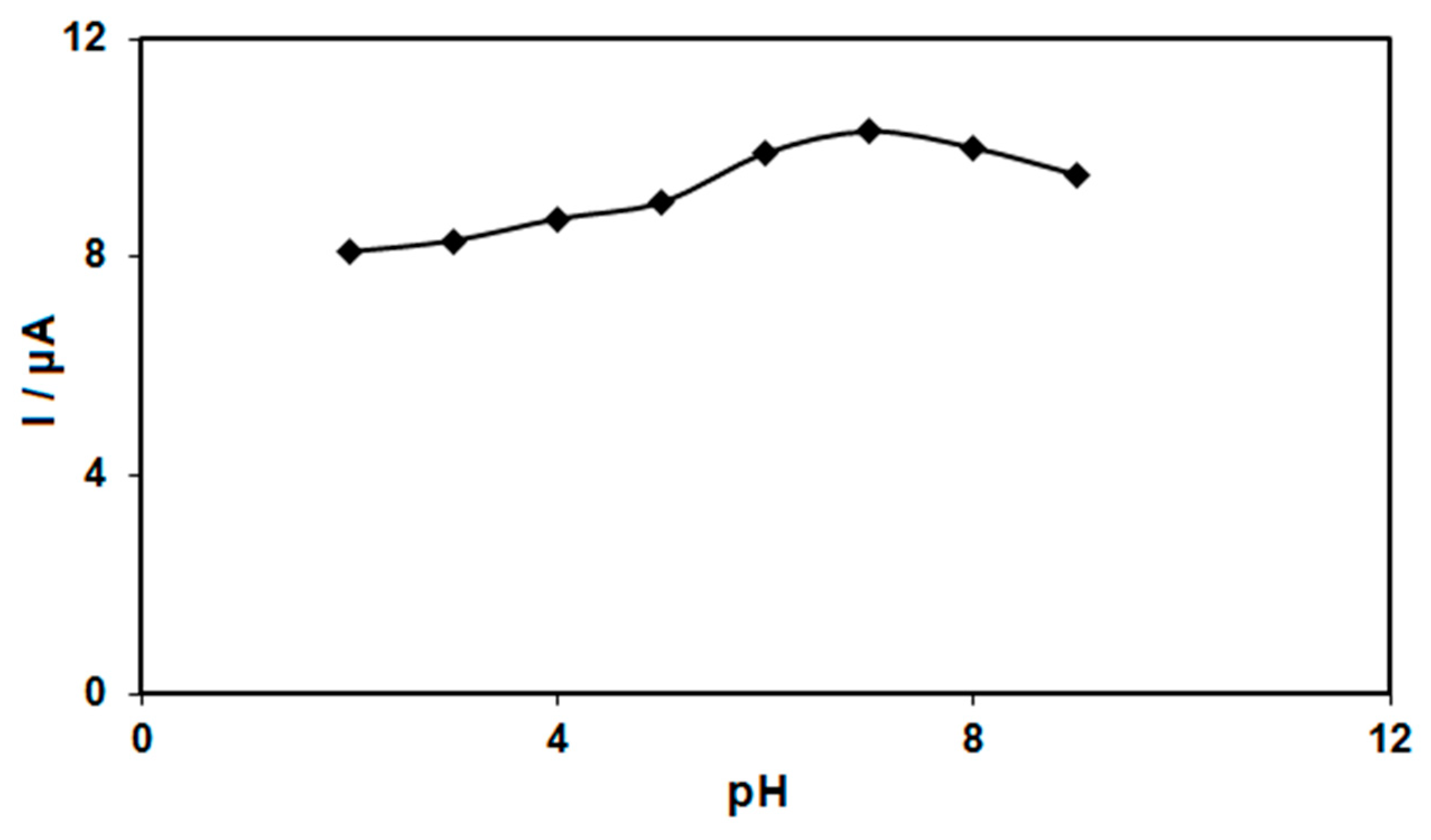
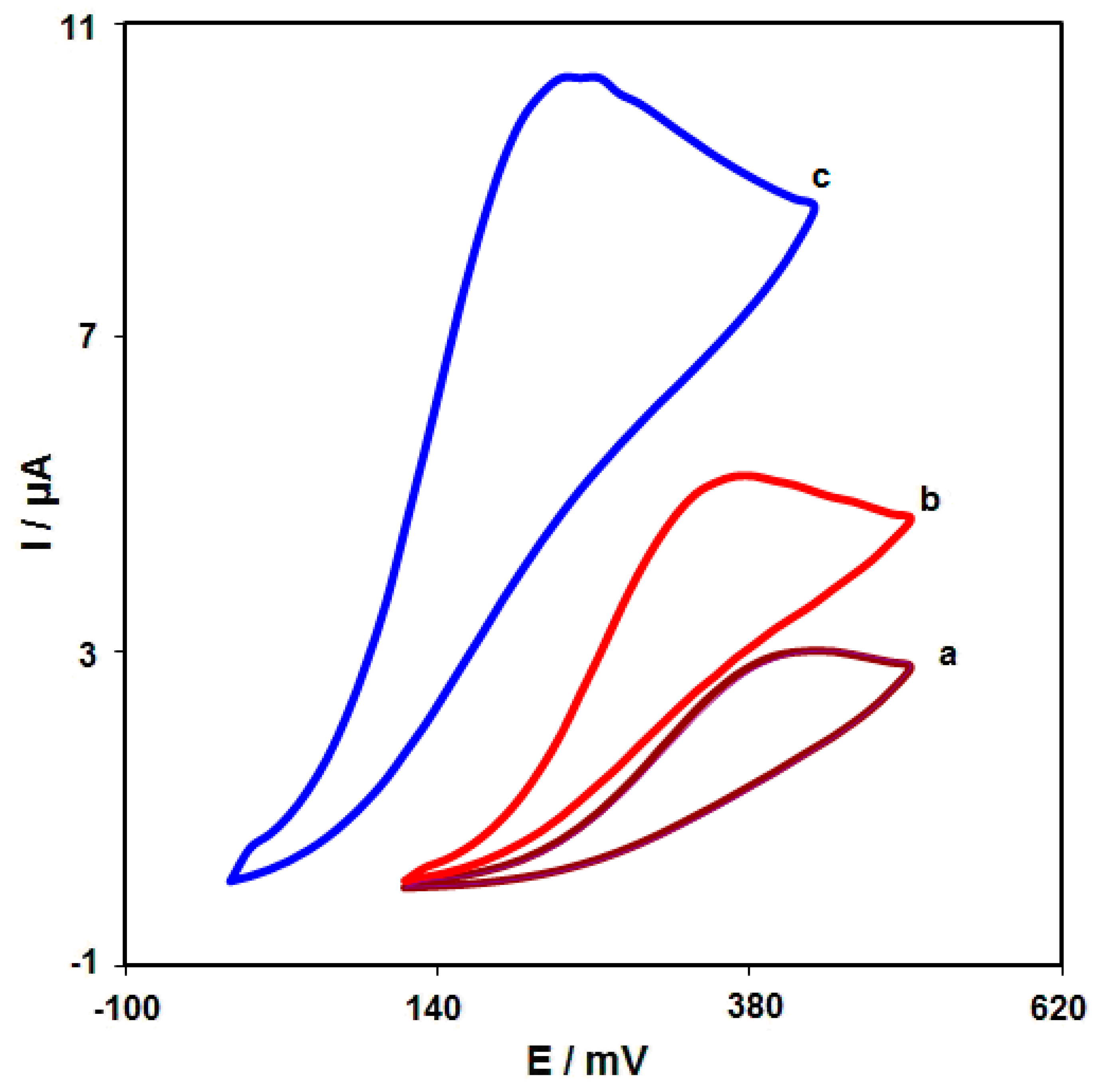
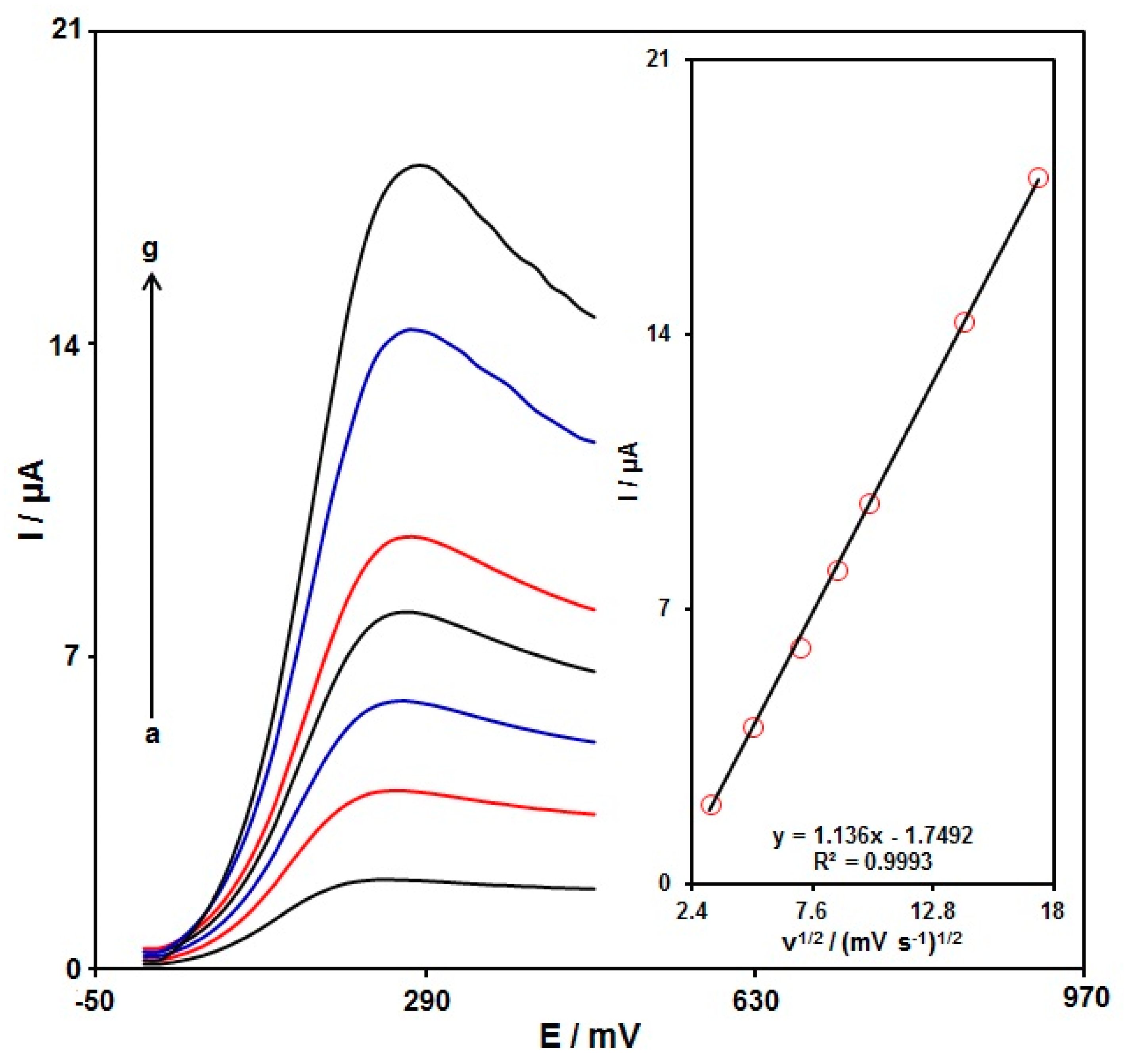

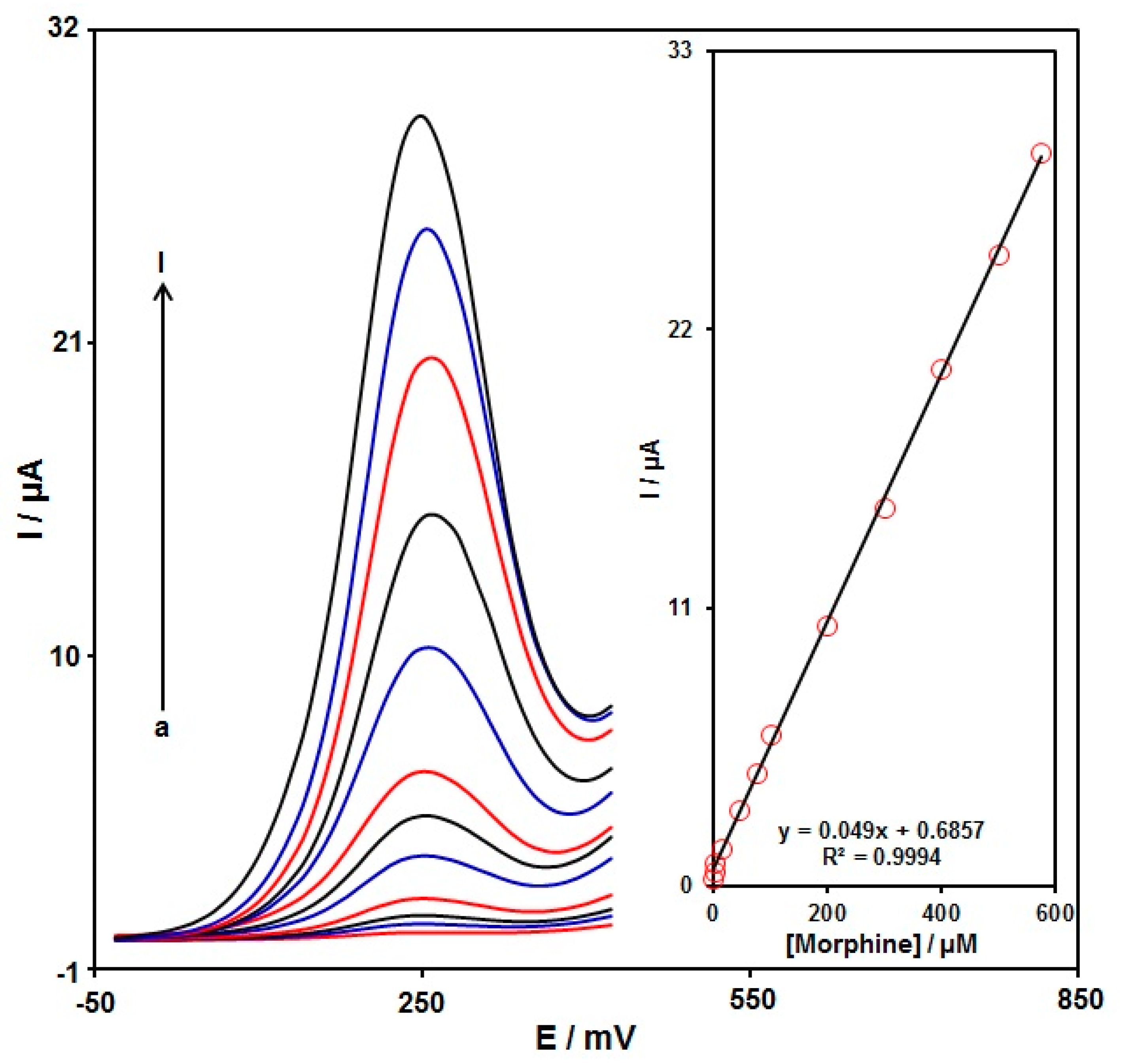

| Electrochemical Sensor | Electrochemical Method | Linear Range | LOD | Ref. |
|---|---|---|---|---|
| ZnO-multi-walled carbon nanotubes (MWCNTs)-ionic liquid/carbon-paste electrode (CPE) | - | 0.1–700.0 μM | 0.06 μM | [1] |
| Polydopamine-modified MWCNTs-glassy Carbon Electrode (GCE) | DPV | 0.075–75.0 μM | 0.06 μM | [37] |
| Poly(cetyltrimethylammonium bromide)/graphene oxide/GCE | DPV | 50–60 μM | 0.36 μM | [38] |
| Au Nanoparticles/CPE | DPV | 4.0 × 10−7–2.0 × 10−4 M | 4.21 nM | [39] |
| Au nanoparticles and Co phthalocyanine/CPE | DPV | 4.0 × 10−7–9.0 × 10−4 M | 5.48 × 10−9 M | [40] |
| Ordered mesoporous carbon/GCE | CV | 0.1–20 μM | 10 nM | [44] |
| Graphene-Co3O4/SPGE | DPV | 0.02–575.0 μM | 0.007 μM | This work |
| Sample | Spiked (μM) | Found (μM) | Recovery (%) | R.S.D. (%) | ||||
|---|---|---|---|---|---|---|---|---|
| Morphine | Diclofenac | Morphine | Diclofenac | Morphine | Diclofenac | Morphine | Diclofenac | |
| Morphine ampoule | 0 | 0 | 3.0 | - | - | - | 3.2 | - |
| 1.0 | 5.0 | 3.9 | 5.1 | 97.5 | 102.0 | 2.7 | 3.5 | |
| 2.0 | 7.0 | 5.1 | 6.9 | 102.0 | 98.6 | 1.9 | 2.1 | |
| 3.0 | 9.0 | 6.2 | 8.8 | 103.3 | 97.8 | 2.4 | 2.6 | |
| 4.0 | 11.0 | 6.9 | 11.1 | 98.6 | 100.9 | 3.0 | 1.8 | |
| Diclofenac tablet | 0 | 0 | - | 4.0 | - | - | - | 2.9 |
| 5.0 | 1.0 | 4.9 | 5.1 | 98.0 | 102.0 | 3.0 | 2.4 | |
| 7.5 | 3.0 | 7.6 | 6.8 | 101.3 | 97.1 | 2.0 | 3.3 | |
| 10.0 | 5.0 | 9.9 | 9.1 | 99.0 | 101.1 | 2.9 | 1.7 | |
| 12.5 | 7.0 | 13.0 | 10.9 | 104.0 | 99.0 | 2.3 | 2.3 | |
| Urine | 0 | 0 | - | - | - | - | - | - |
| 4.0 | 5.5 | 3.9 | 5.6 | 97.5 | 101.8 | 3.1 | 1.8 | |
| 6.0 | 7.5 | 6.2 | 7.4 | 103.3 | 98.7 | 2.8 | 2.9 | |
| 8.0 | 9.5 | 8.1 | 9.8 | 101.25 | 103.2 | 1.9 | 3.5 | |
| 10.0 | 11.5 | 9.9 | 11.1 | 99.0 | 96.5 | 2.2 | 2.4 | |
Publisher’s Note: MDPI stays neutral with regard to jurisdictional claims in published maps and institutional affiliations. |
© 2022 by the authors. Licensee MDPI, Basel, Switzerland. This article is an open access article distributed under the terms and conditions of the Creative Commons Attribution (CC BY) license (https://creativecommons.org/licenses/by/4.0/).
Share and Cite
Beitollahi, H.; Garkani Nejad, F.; Tajik, S.; Di Bartolomeo, A. Screen-Printed Graphite Electrode Modified with Graphene-Co3O4 Nanocomposite: Voltammetric Assay of Morphine in the Presence of Diclofenac in Pharmaceutical and Biological Samples. Nanomaterials 2022, 12, 3454. https://doi.org/10.3390/nano12193454
Beitollahi H, Garkani Nejad F, Tajik S, Di Bartolomeo A. Screen-Printed Graphite Electrode Modified with Graphene-Co3O4 Nanocomposite: Voltammetric Assay of Morphine in the Presence of Diclofenac in Pharmaceutical and Biological Samples. Nanomaterials. 2022; 12(19):3454. https://doi.org/10.3390/nano12193454
Chicago/Turabian StyleBeitollahi, Hadi, Fraiba Garkani Nejad, Somayeh Tajik, and Antonio Di Bartolomeo. 2022. "Screen-Printed Graphite Electrode Modified with Graphene-Co3O4 Nanocomposite: Voltammetric Assay of Morphine in the Presence of Diclofenac in Pharmaceutical and Biological Samples" Nanomaterials 12, no. 19: 3454. https://doi.org/10.3390/nano12193454
APA StyleBeitollahi, H., Garkani Nejad, F., Tajik, S., & Di Bartolomeo, A. (2022). Screen-Printed Graphite Electrode Modified with Graphene-Co3O4 Nanocomposite: Voltammetric Assay of Morphine in the Presence of Diclofenac in Pharmaceutical and Biological Samples. Nanomaterials, 12(19), 3454. https://doi.org/10.3390/nano12193454








